This document discusses strategies for self-care when dealing with the challenges of having a loved one with mental health and substance abuse issues. It outlines both short-term and long-term self-care approaches. Short-term strategies focus on quick activities that can provide relief from stress, such as taking a walk, shower, or spending time with pets. Developing a self-care plan involves identifying personal strengths and engaging in forgiving self-talk to build resilience for long-term challenges. The document provides a resilience questionnaire and tips for strengthening resilience over time through healthy lifestyle habits and social support.



















